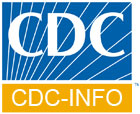Skip directly to the search box, site navigation, or content.
Division of Foodborne, Bacterial and Mycotic Diseases (DFBMD)
Salmonellosis
More information about Salmonellosis and related outbreaks may be found on the Salmonella Topic Page
Surveillance
CDC currently has six surveillance systems for obtaining information about Salmonella. They serve different purposes and provide information on various features of the organism's epidemiology, such as number of outbreaks, antimicrobial-resistant infections, or subtypes.
Public Health Laboratory Information System (PHLIS)
PHLIS is a passive, laboratory-based surveillance system that collects data about many infections, including Salmonella. Reporting is limited to illnesses that are confirmed by culture and verified at the state public health laboratory. After verification, information about the infection is reported electronically to CDC by the state
Annual summaries of PHLIS Salmonella surveillance data.National Electronic Telecommunications System for Surveillance (NETSS)
NETSS is a passive, physician-based surveillance system that captures both laboratory-confirmed and clinically suspected cases of all nationally notifiable diseases, including Salmonella. The number of illnesses reported through NETSS tends to be higher than the number reported through PHLIS because NETSS does not require confirmation by the state public health laboratory.
Salmonella infections and other surveillance data collected by NETSS is published weekly in the CDC Morbidity and Mortality Report (MMWR).
The MMWR also publishes an annual summary of the NETSS Salmonella surveillance data.FoodNet
The Foodborne Diseases Active Surveillance Network (FoodNet) is an active surveillance system for identifying and characterizing culture-confirmed infections that may be foodborne, including Salmonella. FoodNet workers regularly contact more than 300 laboratories for confirmed cases of foodborne infections in several states encompassing a population of more than 25 million persons. In addition to monitoring the number of Salmonella infections, investigators monitor laboratory techniques for isolation of bacteria, perform case-control studies of ill persons to determine foods associated with illness, and administer questionnaires to people living in FoodNet sites to better understand trends in the eating habits of Americans. Annual FoodNet reports that include data about Salmonella.
National Molecular Subtyping Network for Foodborne Diseases Surveillance (PulseNet)
PulseNet is a national network of public health laboratories that perform pulsed-field gel electrophoresis (PFGE), a type of DNA "fingerprinting", on certain foodborne bacteria, including Salmonella. PFGE "fingerprint" patterns are submitted electronically to CDC and can be compared rapidly with others in a large database. This system can help determine if individual infections are related or if an outbreak is occurring. PulseNet is not a surveillance system itself but a laboratory subtyping method used in surveillance.
National Antimicrobial Resistance Monitoring System (NARMS)
NARMS is a passive surveillance system that monitors antimicrobial resistance of Salmonella and selected other bacteria that cause human illness. NARMS is a collaboration between CDC, 16 state and local health departments, the Food and Drug Administration (FDA), and the United States Agricultural Department (USDA).
Electronic Foodborne Outbreak Reporting System
CDC monitors outbreaks of foodborne disease, including outbreaks caused by Salmonella. Each year, state and territorial epidemiologists voluntarily report the results of outbreak investigations to CDC. While outbreaks account for a small percentage of the total number of illnesses that occur each year, these investigations provide valuable information about sources of foodborne infection and often highlight important prevention opportunities. Latest summaries of foodborne outbreaks.
MMWR
Multistate Outbreak of Human Salmonella Infections Associated with Exposure to Turtles - United States, 2007-2008, MMWR January 25, 2008/ Vol. 57/ No. 3/ Pages 69-72.
Salmonella Typhimurium Infection Associated with Raw Milk and Cheese Consumption - Pennsylvania, 2007, MMWR November 9, 2007/ Vol. 56/ No. 44/ Pages 1161-1164.
Salmonella Oranienburg Infections Associated with Fruit Salad Served in Health-Care Facilities - Northeastern United States and Canada, 2006, MMWR October 5, 2007/ Vol. 56/ No. 39/ Pages 1025-1028.
Multistate Outbreaks of Salmonella Infections Associated with Raw Tomatoes Eaten in Restaurants - United States, 2005-2006,MMWR September 7, 2007/ Vol. 56/ No. 35/ Pages 909-911.
Multistate Outbreak of Salmonella Serotype Tennessee Infections Associated with Peanut Butter - United States, 2006-2007, MMWR June 1, 2007/ Vol. 56/ No. 21/ Pages 521-524.
Human Salmonellosis Associated with Animal-Derived Pet Treats - United States and Canada, 2005, MMWR June 30, 2006/ Vol. 55/ No. 25/ Pages 702-705.
Three Outbreaks of Salmonellosis Associated with Baby Poultry from Three Hatcheries -- United States, 2006, MMWR March 30, 2007/ Vol. 56/ No. 12/ Pages 273-276.
Multistate Outbreak of Salmonella Typhimurium Infections Associated with Eating Ground Beef - United States, 2004, MMWR February 24, 2006/ Vol. 55/ No. 7/ Pages 180-182.
Outbreak of Multidrug-Resistant Salmonella Typhimurium Associated with Rodents Purchased at Retail Pet Stores - United States, December 2003-October 2004, MMWR May 6, 2005/ Vol. 54/ No. 17/ Pages 429-433.
Links
References
Olsen SJ, Bishop R, Brenner FW, et al. The changing epidemiology of Salmonella: trends in serotypes isolated from humans in the U.S., 1987-1997. J Infect Dis 2001; 183: 756-761.
CDC. Preliminary FoodNet data on the incidence of infection with pathogens transmitted commonly through food - 10 states, 2006. MMWR 2007; 56: 336-339.
CDC. Outbreak of Salmonella serotype Enteritidis infection associated with eating shell eggs -- United States, 1999-2001. MMWR 2003; 51: 1149-1152.
CDC. Outbreak of multidrug-resistant Salmonella Newport--United States, January-April 2002. MMWR 2002; 51: 545-548.
Content Source: National Center for Zoonotic, Vector-Borne, and Enteric Diseases (ZVED)
Program Contents
Contact Information

